![]()

ran
The Traveling Salesman (1916)
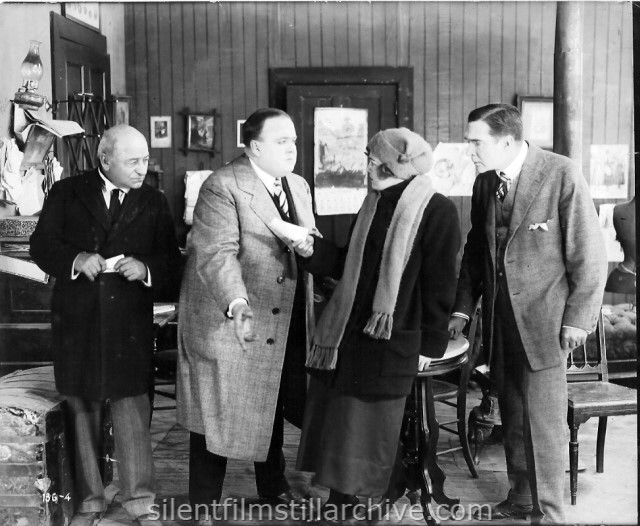
136-4 Russell Bassett, Frank McIntyre, Doris Kenyon, unknown
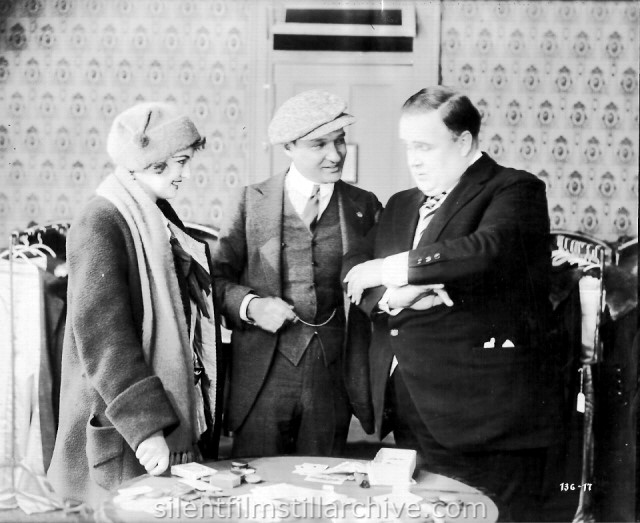
136-17 Doris Kenyon, unknown, Frank McIntyre
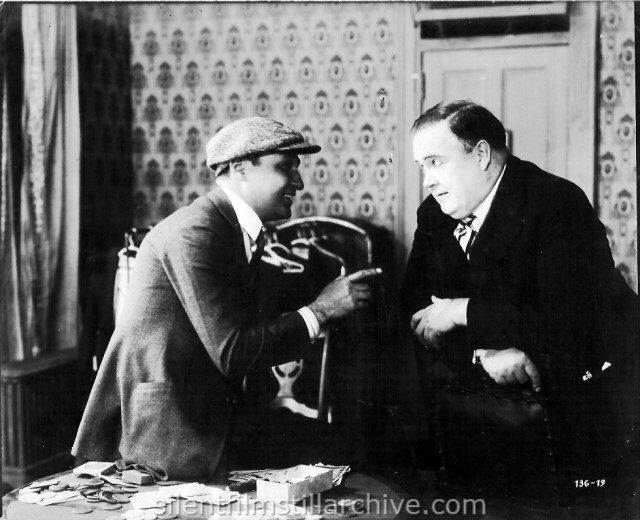
136-19 Unknown, Frank McIntyre
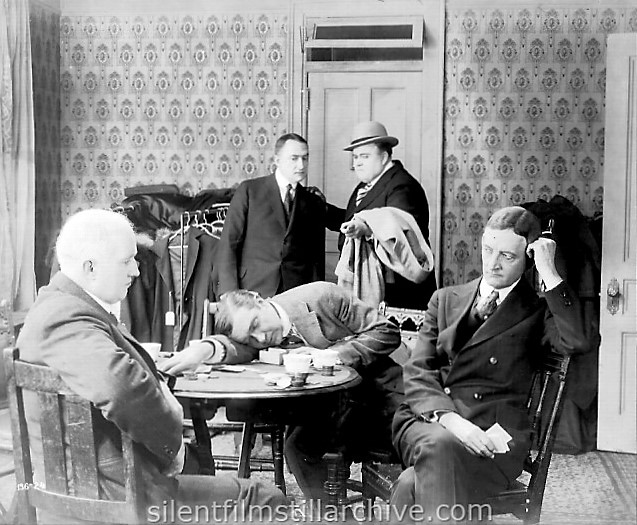
136-24 Russell Bassett (left), Harry S. Northrup (on table), Frank McIntyre (in hat)
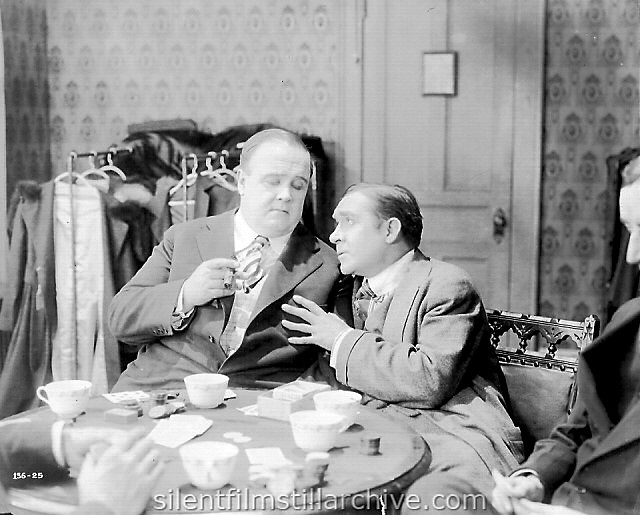
136-25 Frank McIntyre, Harry S. Northrup
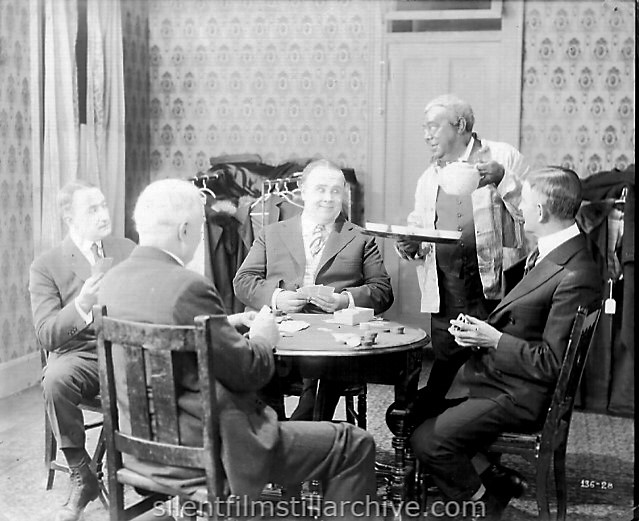
136-28 Frank McIntyre (center)
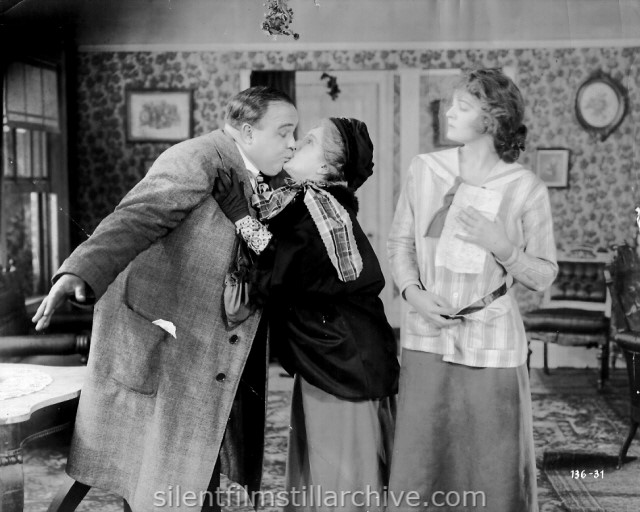
136-31 Frank McIntyre, Julia Stewart, Doris Kenyon
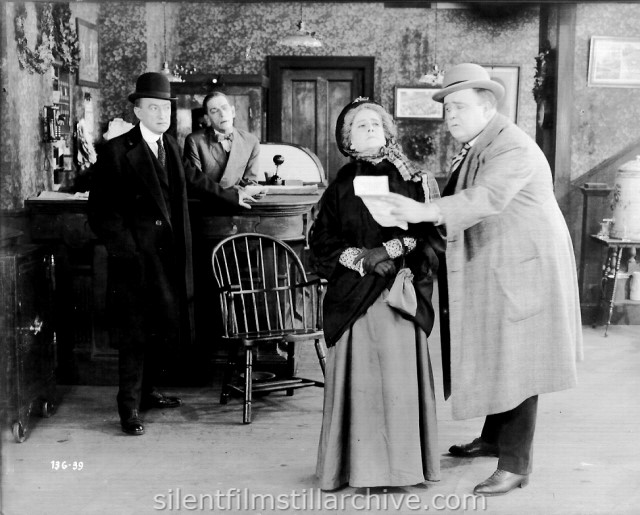
136-39 unknowns, Julia Stewart, and Frank McIntyre
Note: All of these stills were sepia toned and a few were over-exposed so that they do not scan very clearly.
“The Traveling Salesman”
Famous Players Presents Frank McIntyre in an Amusing
Adaptation of His Stage Play
Reviewed by George Blaisdell.
THERE is an entertaining mixture of comedy and drama in “The Traveling
Salesman,” the Famous Players release of December 18. Frank McIntyre
interprets the title role in the adaptation of his old-time stage
success. As Bob Blake, the big drummer, quick to fall in love “on
sight.,” and to quote, or misquote, Shakespeare for justification in that
step, he makes a hit. He has the characteristics, the pep, we ascribe to
the traveling man - human, likable. There may be those who will frown
upon his tendency to uncover liquor in seemingly arid spots: upon the
enjoyment he extracts from a pack of cards when he meets up with his own
fellows, and then again there will be many more who in spirit will sit in
with him and participate in the fun.
Opposite Mr. McIntyre is Doris Kenyon as Beth Elliott, the young
ticket agent in the railroad station whose home is about to be sold for
unpaid taxes, and who falls in love with the “fat man.” Miss Kenyon has
charm and ability in portrayal. Harry Northrup, second to none as a
screen “heavy,” is Franklin Royce, the instrument of Drury, the moneyed
man of the York State village, who seeks to buy in Beth’s land in order
to turn it over to the railroad and “clean up.” Russell Bassett is Drury.
Julia Stuart is Mrs. Babbitt, the energetic and talkative friend of Beth.
The story is staged in a desolate, snow-covered country. Directory Al
Kaufman was fortunate in being able to secure the first fall of the
winter to add to the picturesqueness of the subject. Many of the stage
lines have been employed for the titles, and these add to the comedy
element. The dramatic phase of the picture is reserved for the closing
scenes, and here there is real suspense.
“The Traveling Salesman” is a good subject.
McIntyre in “The Traveling Salesman”
Noted Comedian in Repeat His Stage Success Before Famous
Players Camera for Paramount Program
BY AN arrangement effected this week, Frank McIntyre, the celebrated
comedian, will make his debut on the screen under the auspices of the
Famous Players Film Company, in a picturization of his greatest stage
success, “The Traveling Salesman,” by James Forbes.
This typical American comedy created a mirth-sensation during its
engagement at the Liberty theater, New York, a few years ago, when under
the management of the late Henry B. Harris, Mr. McIntyre’s inimitable
interpretation of the funny drummer was received as one of the most
humorous character creations ever contributed to the stage.
“The Traveling Salesman” was considered to possess unusual screen
material by man of the larger feature producing companies, who have made
frequent and flattering offers to M. McIntyre to enact this
characterization before the camera. His consent to make his photoplay
debut with the company through which so many of his contemporary stage
stars have been introduced to the motion picture public, is therefore in
the nature of a managerial triumph.
Mr. McIntyre has had an interesting stage history, having traversed
all the theatrical paths that lead to stardom, including stock and one
night stand engagements in the earlier years of his career. After his
success in “The Traveling Salesman” he toured the country with it,
repeating his metropolitan hit in all the cities, towns, and hamlets in
which he had formerly appeared under far more trying circumstances as a
struggling artist. Among the play in which has won personal triumphs are
“Captain Malley,” “A Poor Man,” “My Wife’s Husband,” “Major Andre”, and
“The Hat Salesman.”
The plot, in brief, has to do with the romance which develops from the
first meeting of the traveling salesman and the girlish telegraph
operator at Grand Crossing. The girl has some property that two schemers
plan to get away from her by bidding for it when it is up for sale for
taxes. The traveling salesman learns of the plot, foils it and finally
wins out after undergoing all the conditions of misery because the girl
mistrusts him and b in her enemies.
This photoplay comedy will appear on the Paramount Program during the
next few weeks.
-- Moving Picture World, November 4, 1916, page 711
“The Traveling Salesman”
(Famous Players—Paramount—Five
Reels)
REVIEWED BY GEORGE N. SHOREY
FRANK McINTYRE and “The Traveling Salesman” are inseparably associated
on the speaking stage, and now we have this well known comedy drama
transferred to the silent screen. That is has lost much of the character
which Mr. McIntyre’s personality gave it when you could see him in the
flesh, goes without saying. The trivial mannerisms that will set an
audience into fits of laughter when enacted by a living character on the
stage, where they can laugh both at and with him, unusually fall flat
when pictured. And so the cumulative force of a continuous rapid fire of
bright lines and comical actions can not be had in the pictured comedy.
Many humorous bits are registered in the first two reels of this play,
but the real interest only begins when the serious dramatic theme is
introduced and the matching of wits to see who will win the girl get well
under way. From this point the complications of plot unreel, including a
race against time to the court house to save the girl’s inheritance from
the clutches of the village skinflint.
To say that Mr. McIntyre and Doris Kenyon did not make a pleasing play
of a plot that is certainly not burdened with excels weight, would not be
doing justice to the stars, who carry an otherwise ordinary picture
through five reels that will entertain but not cause any extra
enthusiasm. This picture is up to the average of five-reel comedy dramas
so far created, but not a picture that will pull extra dollars into the
house except where those who know Frank McIntyre’s fame come to see his
debut in pictures.
It is, by the way, a Christmas picture, as those familiar with the
story will know, the action happening on Christmas Day, when the
traveling salesman gets carried by his regular stop and falls in love at
first sight with the lady station agent at the small town beyond. Snow
scenes abound. Excellent photography and a number of trick fade-ins as a
means of conveying the thoughts of the actors, as for example in the
poler game the vision of home and loved ones on the cards of each of the
players, add very greatly to the enjoyableness of the play.
The Traveling Salesman, with Frank McIntyre (Paramoung) – “Good. High
class comedy. Sure to please any audience and change grouches to grins.”
– Walton McNeel, Crystal Theater, Burlington, Wisconson.
THE TRAVELING SALESMAN (Famous Players – Five Parts
– Dec. 18) – The cast: Bob Blake (Frank McIntyre); Beth Elliott (Doris
Kenyon); Franklin Royce (Harry Northrup); Mrs. Babbitt (Julia Stuart).
Martin Drury (Russell Bassett); Julius, The Porter (Harry Blakemore);
Watts (James O’Neill).
Because a Pullman porter fails to eject him from his berth in the
morning, Bob Blake, a traveling salesman, is carried past his station on
Christmas morning, and finds himself in Grand Cross. The most interesting
sight in that town is the pretty face that smiles at Blake through the
window of the telegraph office at the station. Blake is rotund, jovial
and trustworthy in appearance, and it is not long before he melts the
natural reserve of Beth Elliott.
During the course of an impromptu luncheon in the station, Blake
learns that Beth’s old home is to be sold for taxes on the following day.
He later gathers the information from Beth’s friend – Mrs. Babbitt, that
the girl has been allowing a Mrs. Stratton to live in the house without
paying her any rent ever since the woman had her little store sold over
her head by Martin Drury, the local capitalist.
By this time Blake has become deeply interested in Beth and through
the medium of a poker game and many applications of “Scotch tea,” learns
that Royce, a henchman of Drury’s, is going to buy in the Elliott place
because Drury has a tip that the railroad is going to want the property
and that it can be sold for a high price. His antagonism to Royce is
heightened by a spice of jealousy – for Royce makes love to Beth openly.
Discovering that Royce is to start to drive for the county seat very
early in the morning, Blake has one of his friends put him to had, and
then gets into the rig in his place. Royce, awakening from the effects of
too much “tea”, makes a violent dash for the livery stable and finds a
small car there which he appropriates and starts in pursuit of Blake.
There is a wild race in which the car is overturned and Blake succeeds in
reaching the court house in time to pay up the taxes in Beth’s name.
Beaten at this game, Royce returns at once and tells Beth that her drummer friend has attempted to steal her property from her, and then persuades her to sell the property to him for $5,000. The girl accepts the check and then Blake dashes in to explain the whole affair, and tears up the check. But Royce has one more trump card – he gets Beth out to the Elliott place alone, and locking the doors, declares that he will not let her go until she accepts the check. After a desperate struggle and Royce, Blake succeeds in freeing the girl and all ends happily.
-- Moving Picture World
with Frank McIntyre, Doris Kenyon. Directed by Joseph Kaufman. Famous Players/Paramount.
More Information on this film...
Books
(None).
Last Modified October 31, 2016



















